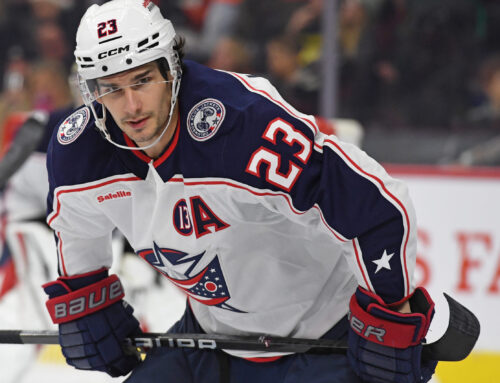You've probably heard by now that Taylor Hall has signed a deal to play in Buffalo. The surprising nature of the choice and the deal has led to a plethora of takes and articles. Dobber is no different with some references here, here, and here. It got me thinking though, this isn't the first time a big-name winger has made a move (or been moved) to play with a big-name center. We are all drooling over the possibility of a point bonanza coming from both Hall and Jack Eichel, but is that how it has worked in the past? What has happened when other big names have been on the move.
To start, let's do a little level setting. Hall has played ten seasons in the NHL by the time of this move, so we have had quite a bit of time to get to know him. He has had four seasons at an 85+ point pace, two seasons at a 90+ point pace and one 100-point pace season (2017-18). Jack Eichel has just completed his fifth season, has increased his point pace every season and ended the 2019-20 season with a 94-point pace. It represents the highest of his career and the second time he has broken a point-per-game pace.
Hall himself would be a logical place to start for a comparison. He moved from Edmonton to New Jersey in 2016-17. In that year he put up 53 points in 72 games, or a 60-point pace. That is not encouraging, however in that case he didn't have a center like Eichel. He played primarily with Travis Zajac and Adam Henrique down the middle and while they are certainly serviceable, they are not Eichel. Hall's most productive seasons came while being centered by Nico Hischier who represents an improvement generally but still has never broken a 56-point pace himself. So it seems, unfortunately there isn't a perfect analogous situation in Hall's own career. With that we turn to other NHL comparisons. Again we will see that there are not perfect comparisons, but we can learn something from each one.
So let's dig into some other possible comparisons. For the first we need to get into the wayback machine because we are heading over to Pittsburgh to look at what happened when Phil Kessel joined the team from Toronto in 2015-16. At the time Kessel had played eight seasons and had a career-high pace of 89 points in 2012-13. He had three seasons with an 80+ point per game pace, but no seasons over 90. He went from being centered by Tyler Bozak to being centered by Evgeni Malkin (an undoubted improvement). At the time Malkin had had one season below a point-per-game pace, and three 100+ point pace seasons. This is a really nice comparison from a player perspective though the team context was a bit different. Pittsburgh had another top center and line so wasn't relying on that pairing by itself. Still we all likely expected Kessel to explode in point production, but instead Kessel finished the year with a 59-point pace the lowest of his career (outside of his rookie year). We do also know that Kessel improved in Pittsburgh, maxing out with a 92-point pace in 2017-18. Clearly there were some growing pains there, but in the end the results were great.
Next I would like to swing down south to Florida and take a look at when Mike Hoffman arrived from Ottawa to play with Aleksander Barkov. We should note right off the top that Hoffman hadn't had quite as an illustrious career as Hall. He spent most of his career in Ottawa just shy of a 70-point pace, setting a then career high of 68 points in four (and a half) seasons. Fast forward to 2018-19 and Hoffman has a chance to line up with Barkov who had not yet truly broken out, but had hit around a 70-point pace for the two prior seasons. Hoffman had been playing with Matt Duchene (in 2017-18) in Ottawa who had one 80+ point pace season to his name. The two seasons Hoffman has been in Florida have been his best, but not to any large degree. His 70-point paces in both years are two points higher than his previous best, but certainly are an improvement from the 62-point pace he had averaged in Ottawa the prior three years. Unfortunately while Barkov and Jonathan Huberdeau exploded in those two seasons, Hoffman did not. In this case I think we can see that move paid immediate dividends for Hoffman, though not necessarily to a large degree.
Moving on to Columbus and New York, let's take a look at Artemi Panarin. Panarin is a slightly different test case for two reasons. One is that he as a player was a little less known than Hall when he made his moves. He only has five seasons under his belt at this point and went to the Blue Jackets with only two seasons played, and the Rangers after four. The other difference here is that Panarin didn't move to a top-notch center. In Columbus he played with Pierre-Luc Dubois, and in New York, Ryan Strome. Neither are of the caliber of Eichel, but it didn't matter much for Panarin. He has taken them (dragged in some cases) to relevance alongside him. In this case Panarin fits the bill of a high-quality winger who moved and had a lot of success, but it doesn't really appear that the center he played with factored into that success.
On to Minnesota and Zach Parise. Back in 2012-13 he moved from New Jersey to the Wild. After five seasons with the Devils, Parise had a 90+ point season and an 83-point-pace season under his belt. He moved to a Minnesota team where he was centered by Mikko Koivu. Koivu, at the time, was a very dependable center, having put up five consecutive 60+ to low 70-point seasons. This case study is pretty good as Parise was moving into a top line situation, and as a player had some high-flying success with New Jersey. It is lacking the Eichel upside for sure, so is not perfect. The move appeared to have absolutely no impact on Parise. He continued around a 70-point pace for the next four seasons, which is right around where he was prior to moving.
Max Pacioretty and Mark Stone are going to play into our last case study. The place is Vegas and the time is 2018-19. Pacioretty had played 10 seasons with Montreal before moving to Vegas. He had quite the down season in 2017-18, right before the move but prior to that had been a very solid high 60s, low 70s-point producer season in, season out. Mark Stone arrived partway through the 2018-19 season after four (and a half) seasons with Ottawa. His tenure in Ottawa was capped with an 88-point pace season, but he had generally been a mid-60s point producer. Pacioretty's stay in Vegas did not start off well. His first full season saw him split time with Paul Stastny and Cody Eakin at center and he maxed out with a 50-point pace. The real change came when Mark Stone arrived. Stone has maintained about an 80-point pace over the season and a half he has spent with Vegas, largely lining up with Pacioretty and Stastny. That is not an improvement over his career high, but about a ten-point improvement over his Ottawa averages. Pacioretty, on the other hand, exploded in 2019-20 to a career high 76-point pace. Again, there are difficulties with both of these analogies as Pacioretty is not quite a Hall-level scorer, and didn't get to play with a Eichel-level scorer, but we can see here that the move initially didn't pan out of him, but it certainly did in the second year. For Stone, the move has definitely agreed with him, though like with Panarin it seems to be less associated with the center he was paired with than his own prowess and the larger team environment he was placed in.
The additional factor in this discussion is the fact that Hall is only signed for one year at the moment, so there is a little extra pressure to either make things happen now or move on. Keeping that in mind here is our summary.
Hall (to NJ): Long-term success, first-year struggles
Kessel: Long-term success, first-year struggles
Hoffman: Short-term success
Panarin: Short-term success (but might have had nothing to do with the moves)
Parise: Neutral
Pacioretty: Potential long-term success, first-year struggles
Stone: Short term success
Our comparisons look great long term, but only okay in the first year. Three of the seven (non-perfect) examples struggled in their first year even if they went on to long-term success. For the most part those difficulties could have been deployment and linemate issues, which Hall hopefully won’t have.
That is all for this week. Thanks for reading.
For all of the Canadiens reading this, happy belated Thanksgiving. For all of the Americans, you have 18 days left (as of Friday) to vote. Make it happen. Got questions about what is going on in your state? This can help.
Stay safe out there.
Want more tool talk? Check out these recent Frozen Tool Forensics Posts.





 EDM
EDM PIT
PIT TOR
TOR VAN
VAN FLA
FLA MIN
MIN DET
DET COL
COL OTT
OTT
